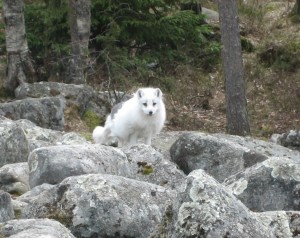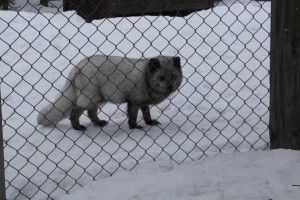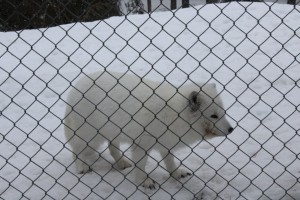The Arctic fox (Alopex lagopus or Vulpes lagopus), also known as the white fox, polar fox, or snow fox, is a small fox native to the Arctic regions of the Northern Hemisphere and common throughout the Arctic tundra biome.
It is well adapted to living in cold environments. It has a deep thick fur which is brown-grey in summer and white in winter. Its body length ranges from 46 to 68 cm (18 to 27 in), with a generally rounded body shape to decrease the escape of body heat. The Arctic fox lives in some of the most frigid extremes on the planet but does not start to shiver until the temperature drops to −70 °C (−94 °F). Among its adaptations for survival in the cold is its dense, multi-layered, pelage which provides excellent insulation, a system of counter-current heat exchange in the circulation within the paws to keep core temperature, and a good supply of body fat.
The Arctic fox eats any small creatures it can find, including lemmings, voles, ringed seal pups, fish, waterfowl, and seabirds. It will also eat carrion, berries, seaweed, insects, and other small invertebrates. The Arctic fox has such keen hearing that it can find exactly where a small animal is moving under the snow. When it has located its prey, it pounces and punches through the snow to catch its victim. Arctic foxes form monogamous pairs during the breeding season and they will stay together to raise their young in complex underground dens. Occasionally, other family members may assist in raising their young.
Metsähallitus (The National Forestry Office of Finland) is responsible for conservation, management and monitoring species on the areas which it manages. In addition, Metsähallitus has the national responsibility of promoting conservation and organizing monitoring of certain threatened species.
At the moment Metsähallitus has extended responsibility for two animals in Finland, and those are the Arctic fox and the Saimaa ringed seal (Phoca hispida saimensis).
Metsähallitus is a state enterprise that administers more than 12 million hectares of state-owned land and water areas. Metsähallitus has the challenging responsibility of managing and using these areas in a way that benefits Finnish society to the greatest extent possible. In Lapland there are large areas that belong to the Metsähallitus responsibility areas.
Metsähallitus has been making researches regarding the Arctic fox since the end of the twentieth century and sadly to say, this year Metsähallitus did not find any activities in nests from Arctic fox in the Finnish Lapland. In fact the last time a nest from Arctic fox with puppies was found in Finland was in 1996 in Utsjoki in the very far north of Finland. The Arctic fox lives in the Norwegian fells on the other side of the Finnish border. In 2014 Metsähallitus checked on 213 nests from Arctic fox, but they did not find any marks of recent activity in them. Metsähallitus has registered 334 old nests from Arctic Fox of which 100 are in such bad shape they are not checked every year anymore.
Species of the Arctic fox were seen in Enontekiö and Utsjoki during last winter. About 100 years ago the Arctic fox was common in these areas, but has decreased dramatically since then. The reason for this has not really been found out.
WWF (World Wildlife Fund) works to make sure fragile ecosystems are supported and protected. They mitigate the effects of climate change to make sure the survival of the Arctic fox and other species.Temperatures in the Arctic are rising at twice the rate of the rest of the world. Warming temperatures are linked to many changes in the Arctic, including reduced sea ice, melting permafrost and rising sea levels and that could be one of the reasons the Arctic fox is moving north to the other side of the border from Finnish Lapland.
The Arctic fox can be seen in the Ranua Wildlife Park, Ranua Zoo.




